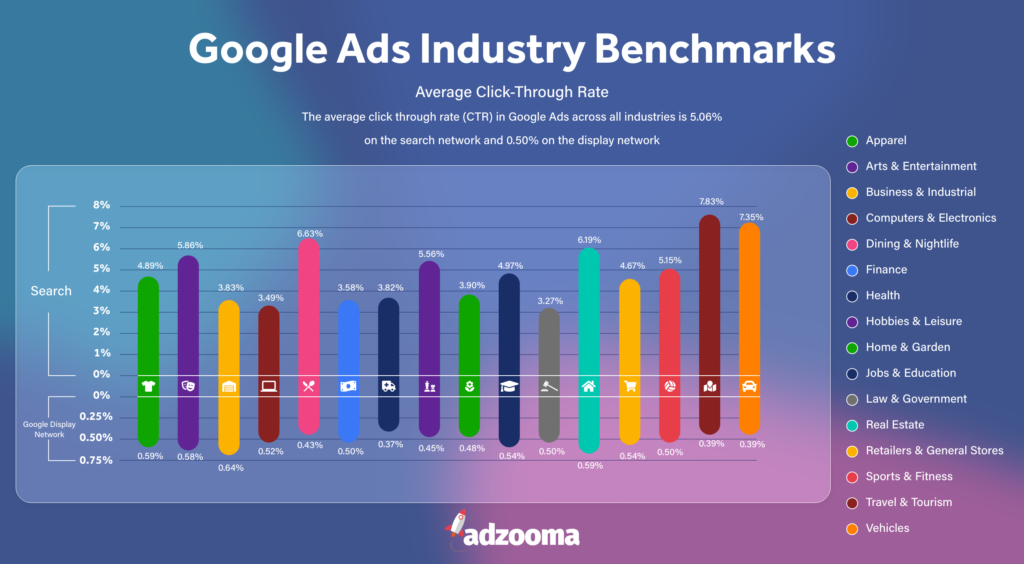Click-through rate (CTR) is a common metric in Google Ads analysis, but what can it tell you on its own, and what is a “good” CTR? Lets guide you through it…
With any Google Ads campaign, it’s important to improve your KPIs where possible. But how do you know if your campaign is performing well or not if you don’t have anything to compare it to?
There are reports that can assess your campaign performance, but if you don’t know the average CTR for your industry, you could be running campaigns that just aren’t hitting the mark like they should.
In this article, we’ll cover what CTR is, how it’s calculated, if there’s such a thing as a ‘good’ CTR, as well as how to improve CTR.
What is CTR?
CTR stands for click-through rate and measures the percentage of clicks an ad gets based on its total number of impressions. An ‘impression’ can be defined as each time an ad is visible on a page, and therefore when an ad is seen.
It’s commonly used to measure the success of an online advertising campaign for a particular website as well as the effectiveness of email campaigns.
Why do click-through rates matter?
Some of the benefits of CTR that tie into the success and cost-effectiveness of a PPC (pay-per-click) campaign include:
- CTRs are linked to Quality Score – the higher your CTR, the better your Quality Score and the cheaper it is to maintain ad position. A high Quality Score is one of the biggest indicators of success in PPC.
- CTR is also a factor in a keyword’s expected CTR, which is part of Ad Rank (ie, what determines your ad’s position on the search results page).
- If you are advertising on relevant queries, achieving a high click-through rate means that you’re driving the highest possible number of people to your offering.
It’s a continuous cycle and click-through rates are a tangible measurement that keeps it turning.
How is click-through rate calculated? The CTR formula
Click-through rate is calculated by dividing the number of clicks by the number of impressions and then multiplied by 100 to convert the number into a percentage.
For a PPC ad that drives 1,000 impressions and 75 clicks, for example, the click-through rate is 7.5% based on the following calculation:
(75 ÷ 1000 = 0.075) x 100 = 7.5%
CTR is used as a better metric over clicks because it shows the rate of success. 1,000 clicks is a lot for a campaign with 5,000 impressions but not so good for a campaign with 500,000 impressions.
What is a good CTR?
To assess what is considered a good CTR, the best place to start is by looking at specific industries and their averages.
Defining your CTR by industry is important because they can differ significantly.
According to Google Ads industry benchmarks for 2021, the average CTR across all industries is 5.06% for search and 0.5% for display when it comes to Google’s industry benchmarks for 2021. Some of the best performing industries include:
- Travel and tourism (7.83%)
- Vehicles (7.35%)
- Dining and nightlife (6.63%)
- Real estate (6.19%)

This data shows you a benchmark to compare yourself to. Your CTR might not have seemed so high in isolation but if it’s performing higher than the industry average, that’s cause for celebration.
The problem with averages is they’re affected by outliers. If a campaign over/underperforms, the average is pulled up or down, and those anomalies could be due to things like seasonality or unexpected events like the COVID-19 pandemic affecting searches.
A ‘good’ CTR depends on several factors, specific to your business and the ad campaigns themselves. You also want to focus on your industry and check what the average is so that you have a good benchmark to work off of when trying to improve your CTR percentage.
If your account is connected to Adzooma you’ll also see a better CTR, since you can use the Opportunities feature to enhance your results.
From the analysis we found for both Google Ads and Microsoft Ads, the click-through rate for the accounts connected to the Adzooma platform was around 6% and 3.7% respectively, which if you’re up on your industry averages, far exceeds the 1.91% and 2.83% you’re expected to see.
So, while you want to aim for a ‘high’ click-through rate, it’s worth bearing in mind that it will vary by industry, and your expected CTR will depend on your ad’s position, among other factors.
Equally, it’s best not to use your industry average as a hard-and-fast rule. It’s one of several guides to assess your performance but ultimately, your own goals should be your priority.
How to improve CTR
Improving your CTR can be done in a number of ways. You can:
- Improve and optimize your ad copy
- Make the keywords you are bidding on more specific and targeted
- Reach your target audience by placing your ad campaigns in front of those you want attention from
- Test your ads more, especially A/B testing
- Understand your audience, whether that’s learning their language and jargon, to talking to your customers directly to see what they want
You can also increase click-through rate with Adzooma Opportunities when you sign up to our free PPC marketing tool.
The tool allows you to monitor your ad campaign, check your CTR and impressions, and enhance the success of your campaign through specific performance suggestions. These include things like adding new keywords, optimizing your ad rotation settings, and increasing device bid adjustments.
It’ll also show you how much time and money these direct suggestions will save your campaign, so you can maximize your results.
FAQs
What is CTR on YouTube?
Simply put, click-through rate for YouTube is the number of clicks, divided by the number of thumbnail impressions, or how many times your video thumbnail is seen on YouTube. Multiply by 100 to get your percentage. For example, if your YouTube thumbnail is seen 1,000 times on YouTube and 100 people then click on it, that’s a click-through rate of 0.1 or 10%.
It’s worth noting that some views don’t count towards impressions, like views on external websites or from end screens, so because of this, your impressions CTR more likely represents a portion of your channel’s total views.
CTR on YouTube will vary depending on the type of content you produce, your audience, and where on YouTube the impression was shown. It’s said that half of all channels have an impressions CTR of between 2% – 10%, with a ‘good’ CTR being 5% and above.
That being said, this is just an average, and other factors need to be taken into consideration – including your subscriber base, your niche, number of views, and how old the video content is.
Why is my CTR so low?
If you’re asking yourself why your CTR is so low, a number of different factors could be affecting it. These include:
- Ad copy that is of poor quality, or doesn’t reflect the offering
- Lack of targeted keywords
- Ads that are irrelevant to the target audience
- Targeting the wrong target audience to begin with, or not speaking their language
- Uninspiring creatives
- Poor Quality Score (based on the quality of your keywords, copy and landing pages, as well as CTR)
- Not testing your ads frequently enough
- Not using ad extensions
Essentially, it means users aren’t finding your ad relevant, while a good CTR, shows that your ad is proving relevant and useful.
If you’re struggling with a low CTR, try our Opportunities tool when you create a free account with Adzooma. It highlights ways you can instantly optimize and improve your ad campaign, which in turn will bolster your CTR.
When is a low CTR ok?
It’s not always the case that a ‘good’ or ‘high’ CTR should be your main KPI or objective.
In fact, sometimes, it’s actually ok to have a low CTR. If, for example, you’re bidding on an ambiguous keyword, for which there could be multiple meanings and purposes, it might be harder to get a higher CTR.
That said, if you do get a lot of leads from that keyword, at a good cost, then go with it.
After all, it can be just as problematic having a high CTR, but low conversions, since you could end up paying for clicks that don’t turn into customers.
So, in essence, as long as your keywords and ads are performing well as per your business objectives, don’t worry too much over a CTR that’s slightly on the low side. It’s just one of many metrics to take into consideration.




